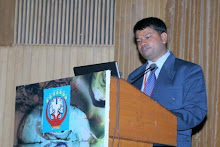Lingavantha in Kannada, meaning 'one who wears Linga on their body'. . . . also known as Veerashaivism (Brave + Shaiv!) . . . It makes several departures from mainstream Hinduism . . . founded by Panchacharyas (Five prophets . . . five principles?) . . . Basavanna was a social reformer and a great humanitarian who was mainly responsible for reviving Veerashaiva religion in 12th Century . . . He travelled from his native Bagevadi to Kalyan . . . It is said that Basava, though born a brahmin, rebelled against the rigid practices of the caste system. Basavanna preached that the devotion of people to God was a direct relationship and did not need the intervention of the priestly class. Temple building is generally not practised among Lingayats.Lingayatism says that GOD has no specific form, name, place. He is omnipresent, unique, Kind and Friendly. Ishtalinga is worn on body. Any human being on earth can wear Ishtalinga initiated by Guru of Lingayat religion. Lingayatism does not make any partiality of humankind based on caste, creed, gender, language, country, or skin color. Everybody are equal in the eyes of GOD. Lingaytism stands for Fatherhood of GOD and Brotherhood of all Human beings, and compassion towards all living beings. While Hindus beieve that one's sins can be washed away by bathing in the Ganges river, Lingayats do not believe in such practices. They also do not believe in rituals and astrology. They believe in "Jangama (mobile) linga" carried in/on one's body as against "Sthavara (stationary) linga" such as in temples.
The Vokkaligas are other major caste or social group found mainly in the Old Mysore Region of southern Karnataka state. Tamil nadu they are known as Okkaligarand use Gowder as a title. The Vokkaliga belong to the Vaisya (cultivator - Yadav/ Baniya of north!) varna within Hinduism sometimes classified as satvic.
The Yelahankanadu Prabhus were Gowdas or tillers of the Land. They belonged to Morasu Vokkalu sect, the ancestors of which were migrants. Fourth in succession from Rana Bhairave Gowda, founder of the dynasty of Avati Nadu Prabhus and great grandson of Jaya Gowda, who established separate dynasty, is the famous Yelahanka Nadu Prabhus, Kempe Gowda I who ruled for 46 years commencing his reign from 1513. Jaya Gowda accepted the sovereignty of the Vijayanagar emperor and that termed the end of their empire.
The Lingayats and the Vokkaligas have been dominant in Karnataka since time immemorial and the tussle for power between these two communities is no secret. Karnataka has till date had five chief ministers from the Vokkaliga community, and six have been Lingayats. There were three CMs from the backward classes while Brahmins managed to hold the top spot in Karnataka twice.
When B S Yeddyurappa was dumped by the Janata Dal-Secular barely a week after he assumed power, it was said it was not just a betrayal for the party, but of the entire Lingayat community.
H D Deve Gowda, saw that the support for Yeddyurappa was growing leaps and bounds. Initially Gowda took it easy as he had M P Prakash, a strong Lingayat leader, in his ranks. However, with Prakash parting ways and joining the Congress, Gowda realised that it was time he too used the caste card. Gowda decided to use the Vokkaliga card while making it clear that his community would rally behind the JD-S. The Congress too sensed that the elections would largely be fought on the caste factor and roped in S M Krishna, also a Vokkaliga leader, at the last minute.
The Vokkaligas, who comprise 15 per cent of the 5 crore-odd population of Karnataka, are spread mainly across Bangalore, Mandya, Hassan, Mysore, Kolar and Chikamagalur. The Lingayats comprise 17 per cent of the population of Karnataka and are dominant in the central and northern parts of Karnataka.
The Dalits in Karnataka comprise 23 per cent of the population, Kurubas 8 per cent while the Muslims make up 10 per cent. The rest of the population comprises Christians and others.
Bloody politics!
